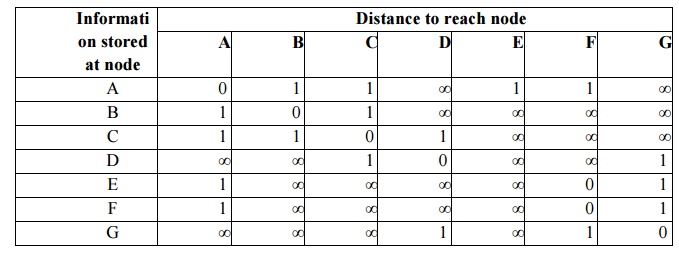Chapter: Computer Networks : Routing
Routing Information Protocol (RIP)
ROUTING INFORMATION PROTOCOL
(RIP)
Each node
constructs a one-dimensional array (a vector) containing the “distances”
(costs) to all other nodes and distributes that vector to its immediate
neighbors. The starting assumption for distance-vector routing is that each
node knows the cost of the link to each of its directly connected neighbors. A
link that is down is assigned an infinite cost.
The cost
of each link is set to 1, so that a least-cost path is simply the one with the
fewest hops. (Since all edges have the same cost, we do not show the costs in
the graph. Note that each node only knows the information in one row of the
table (the one that bears its name in the left column). The global view that is
presented here is not available at any single point in the network.

Initial distances stored at each
node (global view).
Implementation
The code
that implements this algorithm is very straightforward; we give only some of
the basics here. Structure Route defines each entry in the routing table, and
constant MAX_TTL specifies how long an entry is kept in the table before it is
discarded. One of the most widely used routing protocols in IP networks is the
Routing Information Protocol (RIP). Its widespread use is due in no small part
to the fact that it was distributed along with the popular Berkeley Software
Distribution (BSD) version of UNIX, from which many commercial versions of Unix
were derived. It is also extremely Simple.
#define
MAX_ROUTES 128 /* maximum size of routing table */ #define MAX_TTL 120 /* time
(in seconds) until route expires */ typedef struct {
NodeAddr
Destination; /* address of destination */ NodeAddr NextHop; /* address of next
hop */
int Cost;
/* distance metric */ u_short TTL; /* time to live */ } Route;
int
numRoutes = 0;
Route
routingTable[MAX_ROUTES];
RIP is in
fact a fairly straightforward implementation of distance-vector routing.
Routers running RIP send their advertisements every 30 seconds; a router also
sends an update message whenever an update from another router causes it to
change its routing table. One point of interest is that it supports multiple
address families, not just IP. The network-address part of the advertisements
is actually represented as a _family, address_ pair.
Related Topics